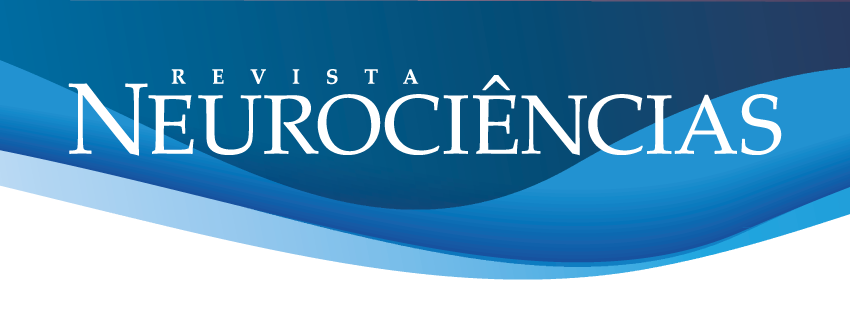Complicações Neurológicas oriundas da infecção por SARS-CoV-2: uma revisão da literatura.
DOI:
https://doi.org/10.34024/rnc.2020.v28.10789Palavras-chave:
COVID-19, SARS-Cov-2, neurologia, Sistema nervosoResumo
Introdução. A COVID-19 é causada pelo coronavirus 2 da síndrome respiratória aguda grave (SARS-CoV-2), que teve seus primeiros casos relatados em dezembro de 2019. O vírus apresenta material genético contituido de RNA de fita simples. SARS-CoV-2 apresenta capacidade de invasão de tecidos que não estão contidos no sistema respiratório e a invasão do sistema nervoso nervoso central vêm sendo documentada na literatura. Objetivos. Apontar os sintomas e complicações neurológicas relatados em pacientes infectados pelo SARS-CoV-2. Método. A pesquisa foi realizada nas bases de dados PUBMED, EMBASE, New England Journal of the Medicine, JAMA neurology, Nature medicine e Google Acadêmico sem restrição de idiomas. Houve a combinação das palavras-chave “covid-19”, “neurology” e “SARS-CoV-2”. Resultados. Febre estava presente em 48,14% dos pacientes, paresias em 40,74% e estado mental alterado em 33,33% dos indivíduos. Distúrbios do olfato e do paladar estão presentes em 14,81% dos casos. Afasia foi descrita em 7,40% dos pacientes, disartria em 25,92%, ataxia 14,81% e hemiplegia em 22,22% dos casos. Ademais, 48,14% sofreram algum tipo de acidente vascular cerebral (AVC), enquanto 25,92% cursaram com Síndrome de Guillain Barré (SGB) e 14,81% evoluíram com encefalite. Conclusão. Ainda há poucas evidências que permitam afirmar com precisão quais são os mecanismos exatos de invasão do tecido nervoso, mas já se tem a evidência que esse processo existe.
Métricas
Referências
Guan W, Ni Z, Hu Y, Liang W, Ou C, He J, et al. Clinical Characteristics of Coronavirus Disease 2019 in China. N Engl J Med 2020;382:1708-20. https://doi.org/10.1056/NEJMoa2002032
Baig AM, Khaleeq A, Ali U, Syeda H. Evidence of the COVID-19 Virus Targeting the CNS: Tissue Distribution, Host−Virus Interaction, and Proposed Neurotropic Mechanisms. ACS Chem Neurosci 2020;11:995-8. https://doi.org/10.1021/acschemneuro.0c00122
Lan J, Ge J, Yu J, Shan S, Zhou H, Fan S, et al. Structure of the SARS-CoV-2 spike receptor- binding domain bound to the ACE2 receptor. Nature 2020;518:215-20. https://doi.org/10.1038/s41586-020-2180-5
Asadi-Pooya AA, Simani L. Central nervous system manifestations of COVID-19: A systematic review. J Neurol Sci 2020;413:1-4. https://doi.org/10.1016/j.jns.2020.116832
Kwong KCNK, Mehta PR, Skukla G, Mehta AR. COVID-19, SARS and MERS: A neurological perspective. J Clin Neurosci 2020;77:13-6. https://doi.org/10.1016/j.jocn.2020.04.124
Zubair AS, McAlpine LS, Gardin T, Farhadian S, Kuruvilla DE, Spudich S. Neuropathogenesis and Neurologic Manifestations of the Coronaviruses in the Age of Coronavirus Disease 2019 A Review. JAMA Neurol 2020;77:1018-27.
https://doi.org/10.1001/jamaneurol.2020.2065
Mao L, Jin H, Wang M, Hu Y, Chen S, He Q, et al. Neurologic Manifestations of Hospitalized Patients With Coronavirus Disease 2019 inWuhan, China. JAMA Neurol 2020;77:683-90. https://doi.org/10.1001/jamaneurol.2020.1127
Avula A, Nalleballe K, Narula N, Sapozhnikov S, Dandu V, Toom S, et al. COVID-19 presenting as stroke. Brain Behav Immun 2020;87:115-9. https://doi.org/10.1016/j.bbi.2020.04.077
Moriguchi T, Harii N, Goto J, Harada D, Sugawara H, Takamino J, et al. A first case of meningitis/encephalitis associated with SARS-Coronavirus-2. Int J Infect Dis 2020;94:55-8. https://doi.org/10.1016/j.ijid.2020.03.062
Muhammad S, Petridis A, Cornelius JF, Hänggi D. Severe brain haemorrhage and concomitant COVID-19 Infection: A neurovascular complication of COVID-19. Brain Behav Immun 2020;87:150-1. https://doi.org/10.1016/j.bbi.2020.05.015
Ye M, Ren Y, Lv T. Encephalitis as a clinical manifestation of COVID-19. Brain Behav Immun 2020;88:945-6. https://doi.org/10.1016/j.bbi.2020.04.017
Huang H, Jiang D, Huang JT. SARS-CoV-2 Detected in Cerebrospinal Fluid by PCR in a Case of COVID-19 Encephalitis. Brain Behav Immun 2020;87:149. https://doi.org/10.1016/j.bbi.2020.05.012
Sedaghat Z, Karimi N. Guillain Barre syndrome associated with COVID-19 infection: A case report. J Clin Neurosci 2020;76:233-5. https://doi.org/10.1016/j.jocn.2020.04.062
Coen M, Jeanson G, Almeida LAC, Hübers A, Stierlin F, Najjar I, et al. Guillain-Barré Syndrome as a Complication of SARS-CoV-2 Infection. Brain Behav Immun 2020;87:111-2. https://doi.org/10.1016/j.bbi.2020.04.074
Tunç A, Ünlübaş Y, Alemdar M, Akyüz E. Coexistence of Covid-19 and Acute Ischemic Stroke Report of Four Cases. J Clin Neurosci 2020;77:227-9. https://doi.org/10.1016/j.jocn.2020.05.018
Oxley TJ, Mocco J, Majidi S, Kellner CP, Shoirah H, Singh P, et al. Large-Vessel Stroke as a Presenting Feature of Covid-19 in the Young. N Engl J Med 2020;382:e60. https://doi.org/10.1056/NEJMc2009787
Toscano G, Palmerini F, Ravaglia S, Ruiz L, Invernizzi P, Cuzzoni MG, et al. Guillain–Barré Syndrome Associated with SARS-CoV-2. N Engl J Med 2020;382:2574-6. https://doi.org/10.1056/NEJMc2009191
Pellitero SE, Ferrer-Bergua L. Paciente con clínica neurológica como única manifestación de infección por SARS-CoV-2. Neurologia 2020;35:271-2. https://doi.org/10.1016/j.nrl.2020.04.010
Politi LS, Salsano E, Grimaldi M. Magnetic Resonance Imaging Alteration of the Brain in a Patient With Coronavirus Disease 2019 (COVID-19) and Anosmia. JAMA Neurol 2020;77:1028-9. https://doi.org/10.1001/jamaneurol.2020.2125
Duong L, Xu P, Liu A. Meningoencephalitis without respiratory failure in a young female patient with COVID-19 infection in Downtown Los Angeles, early April 2020. Brain Behav Immun 2020;87:33. https://doi.org/10.1016/j.bbi.2020.04.024
Carod-Artal FJ. Complicaciones neurológicas por coronavirus y COVID-19. Rev Neurol 2020;70:311-22. https://doi.org/10.33588/rn.7009.2020179
Harapan H, Itoh N, Yufika A, Winardi W, Keam S, Te H, et al. Coronavirus disease 2019 (COVID-19): A literature review. J Infect Public Health 2020;13:667-73. https://doi.org/10.1016/j.jiph.2020.03.019
Shang J, Ye G, Shi K, Wan Y, Luo C, Aihara H, et al. Structural basis of receptor recognition by SARS-CoV-2. Nature 2020;581:221-38. https://doi.org/10.1038/s41586-020-2179-y
Sungnak W, Huang N, Bécavin C, Berg M, Queen R, Litvinukova M, et al. SARS-CoV-2 entry factors are highly expressed in nasal epithelial cells together with innate immune genes. Nat Med 2020;26:681-7. https://doi.org/10.1038/s41591-020-0868-6
Troyer EA, Kohn JN, Hong S. Are we facing a crashing wave of neuropsychiatric sequelae of COVID-19? Neuropsychiatric symptoms and potential immunologic mechanisms. Brain Behav Immun 2020;87:34-9. https://doi.org/10.1016/j.bbi.2020.04.027
Downloads
Publicado
Edição
Seção
Como Citar
Aprovado 2020-10-05
Publicado 2020-11-23


